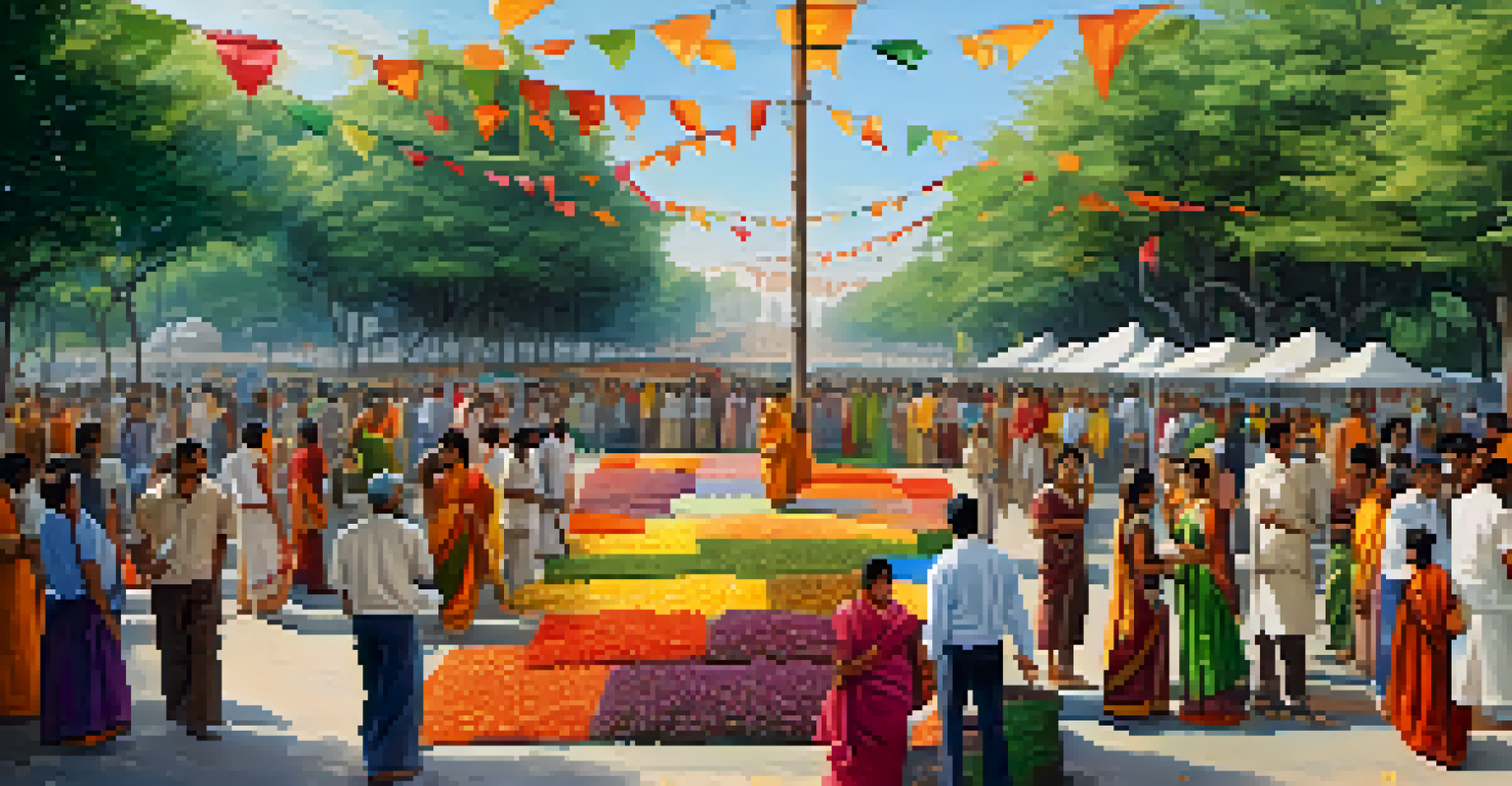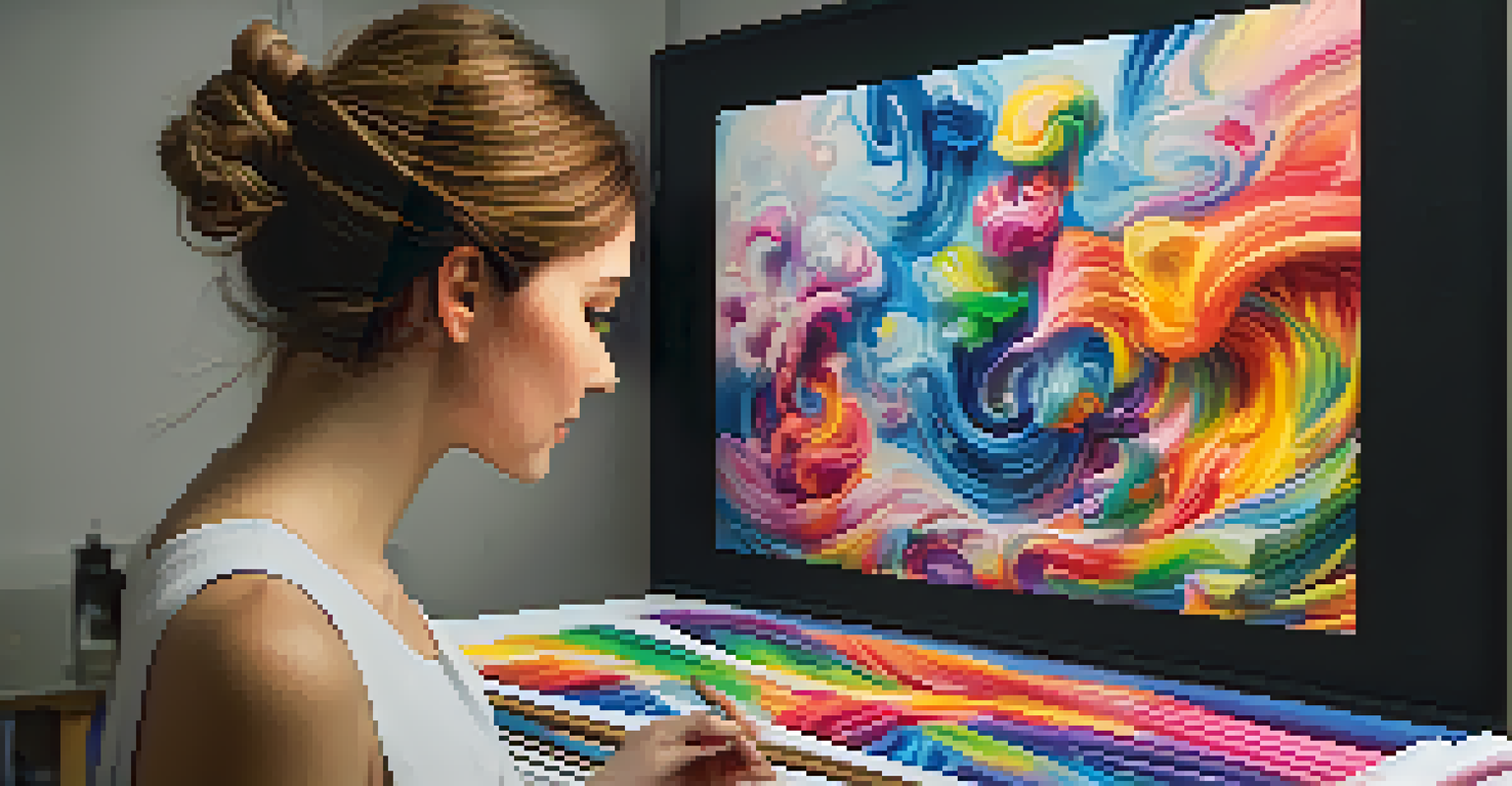Exploring India's Contemporary Art Installations and Exhibitions

Introduction to Contemporary Art in India
Contemporary art in India is a vibrant reflection of the country's diverse culture and rapid modernization. Artists are pushing boundaries, experimenting with new forms and materials, and addressing pressing social issues through their work. This dynamic field is not just about aesthetics; it's a conversation starter that engages audiences on multiple levels.
Art is a reflection of society, and contemporary art in India captures the complexity and diversity of its people.
In recent years, there has been a noticeable increase in the number of art installations and exhibitions across the country. From bustling metros like Mumbai and Delhi to smaller cities, art is becoming accessible to a broader audience. This democratization of art is crucial in fostering a deeper appreciation and understanding of contemporary issues.
As we delve deeper into India's contemporary art scene, we will explore notable installations and exhibitions that exemplify the creativity and relevance of this movement. Each piece tells a story, inviting viewers to engage with the complexities of life in modern India.
Key Themes in Contemporary Indian Art
Several themes dominate contemporary Indian art, reflecting the socio-political landscape of the country. Artists often grapple with identity, globalization, and the impact of technology on society. These themes resonate deeply with audiences, prompting them to reflect on their own experiences and the world around them.

For instance, many artists examine the clash between tradition and modernity, depicting how age-old customs are adapting to contemporary life. This exploration can be seen in various forms, from paintings and sculptures to multimedia installations. Each artist brings their unique perspective, adding to a rich tapestry of narratives.
Diverse Themes in Indian Art
Contemporary Indian art explores key themes like identity, globalization, and social issues, reflecting the country's complex socio-political landscape.
Additionally, social issues such as gender inequality, environmental degradation, and communal tensions are frequently highlighted in contemporary art. By tackling these subjects, artists not only create awareness but also challenge viewers to think critically about the world we live in.
Prominent Contemporary Artists in India
India boasts an array of talented contemporary artists who have made significant contributions to the global art scene. Names like Subodh Gupta, known for his use of everyday materials, and Bharti Kher, who incorporates traditional motifs with modern themes, stand out. Their innovative approaches have garnered international acclaim and sparked conversations around the globe.
The role of the artist is to ask questions, not to answer them.
Another artist worth mentioning is Atul Dodiya, whose work often reflects the complexities of urban life in India. His installations frequently blend personal and historical narratives, creating a dialogue between the past and present. This multifaceted approach allows viewers to connect deeply with the artwork.
These artists, among many others, not only enrich the contemporary art landscape but also inspire emerging talents. Their ability to weave personal stories into broader societal issues creates a sense of relatability and urgency in their work, making it accessible to a wide audience.
Notable Art Installations Across India
India is home to some truly remarkable art installations that showcase the creativity of contemporary artists. One such installation is 'The Great Indian Circus' by artist Shilpa Gupta, which explores themes of nationalism and identity through a playful yet thought-provoking lens. By using interactive elements, Gupta invites viewers to participate in the experience, making the art more engaging.
Another installation worth mentioning is 'Kaleidoscope' by artist Reena Saini Kallat, which uses light and color to represent the diverse cultures of India. This work not only captivates the eye but also encourages reflection on the interconnectedness of various communities. It's a stunning representation of unity in diversity, a theme central to Indian society.
Impact of Technology on Art
The integration of technology in contemporary art, from digital mediums to social media, is reshaping how artists create and engage with audiences.
These installations, among others, illustrate the innovative spirit of contemporary Indian artists. They challenge conventional art forms, inviting viewers to experience art in new and exciting ways, ultimately expanding the boundaries of what art can represent.
Major Art Exhibitions Showcasing Contemporary Works
Art exhibitions play a crucial role in promoting contemporary Indian art, providing a platform for artists to showcase their work. Events like the Kochi-Muziris Biennale, held in Kerala, have gained international recognition for their celebration of contemporary art. This biennial event not only highlights Indian artists but also welcomes global talents, creating a melting pot of ideas and expressions.
Similarly, the India Art Fair, held annually in Delhi, showcases a wide range of contemporary art from across the country. This event attracts art lovers, collectors, and curators, offering an opportunity to engage with the latest trends and emerging talents in the Indian art scene. The fair is a vibrant celebration of creativity and innovation.
These exhibitions are vital for fostering dialogue around contemporary art, allowing artists to connect with audiences and share their narratives. They create an environment where art can thrive, encouraging collaboration and cross-cultural exchanges.
The Role of Technology in Contemporary Art
Technology has become an integral part of contemporary art, enabling artists to explore new mediums and reach wider audiences. Digital art, virtual reality installations, and interactive exhibits are just a few examples of how technology is reshaping the art landscape. This evolution not only enhances the creative process but also transforms the way we experience art.
For instance, artist Sandeep Mukherjee has utilized augmented reality to create immersive experiences that challenge viewers' perceptions of reality. By combining traditional art forms with cutting-edge technology, Mukherjee invites audiences to engage with the artwork in a novel way. This fusion of art and technology opens up exciting possibilities for artistic expression.
Diverse Themes in Indian Art
Contemporary Indian art tackles themes like identity, globalization, and social issues, prompting audiences to reflect on their own experiences.
Moreover, social media platforms have become vital tools for artists to showcase their work and connect with global audiences. Through platforms like Instagram, artists can share their creative processes and engage directly with fans. This accessibility has democratized the art world, allowing emerging artists to gain visibility and recognition.
Future Trends in Indian Contemporary Art
As we look ahead, several trends are shaping the future of contemporary art in India. One significant trend is the growing emphasis on sustainability, with artists increasingly using eco-friendly materials and addressing environmental issues in their work. This shift reflects a broader awareness of the impact of art on the planet and encourages a more responsible approach to creativity.
Additionally, there is a rising interest in interdisciplinary practices, where artists collaborate with professionals from various fields, such as science and technology. This blending of disciplines not only enriches the artistic experience but also fosters innovation and new ways of thinking. It opens up exciting avenues for exploration and expression.

Finally, the global art scene's increasing interest in Indian contemporary art promises to elevate its status on the world stage. As international collectors and institutions recognize the significance of Indian artists, we can expect to see even more opportunities for collaboration and exchange, further enriching the cultural landscape.